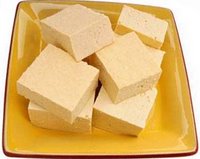Thai vegetarian cooking (ingredients)
 Rice (Khao Jao): There are many different varieties of rice. We recommend Thai Jasmine rice. It has a flavor and aroma similar to that of roasted popcorn or nuts, and a soft, moist texture that clings together. In the north eastern part of Thailand Glutinous rice (khao niaow), better known as sticky rice, is the most popular. When cooked, this rice loses its shape and is very glutinous.
Rice (Khao Jao): There are many different varieties of rice. We recommend Thai Jasmine rice. It has a flavor and aroma similar to that of roasted popcorn or nuts, and a soft, moist texture that clings together. In the north eastern part of Thailand Glutinous rice (khao niaow), better known as sticky rice, is the most popular. When cooked, this rice loses its shape and is very glutinous.Palm Sugar (Nam Tarn): In the old days this type of sugar was made from the sap of sugar palms (palmyra), but nowadays it's usually made from the sap of coconut trees and is there fore sometimes called coconut sugar.
Tofu (Tao Hu): By many Thai cooks it's dictionary-translated to just "bean curd(s)". Tofu comes in yellow or white blocks and strongly resemble cheese in more than way. The white tofu (tao hu khao chaniton) is usually called Soft (or Silken) Tofu and is predominately used in soups or for raw consumption, while the yellow tofu (tao hu leuang) is called Firm Tofu and is salty. It can be baked, boiled, broiled, grilled, or fried.
Soy sauces (Si Iu): In vegetarian cooking we use both light soy sauce (si iu khao), which is mostly used as a substitute for fish sauce in non-vegetarian dishes, as well as dark soy sauce (si iu dam), which can be used to add color to certain dishes or as a dipping sauce.
Soy Bean paste (Tao Jiao Nam): a mixture of fermented soybeans and flour.
Chillies (Phrik): there are many different types of chillies available. The bird chillies (Phrik Khi Nu): seem to be most popular in Thai cooking. They are the least hot when they are green and most hot after they have changed to a dark red. Spur chilli (phrik chi fa): These become red, orange, or yellow when ripe and are extreemly hot. Sun dried Chillies (Phrik Heang) can give the true hot lover even an extra kick.
Garlic (Krathiam):The Thai garlic is somewaht smaller than it's cousin from other territories, but both are used in the Thai kitchen. The Thai garlic is more fragrant and, according to some, more hot and spicy than the regular garlic. It's cloves are smaller, which makes it less important to slice them before use.
Shallots (Hom Lek or Hom Deang): The small red unions that are especially popular in many of the E-sarn dishes.
Kaffir Lime (Ma Krut): Best described as wrinkled limes. Both the fruit itself, as well as the leaves are used in the Thai cooking.
Coriander Plant (Phak Chi): popular for flavouring, but best known as a garnish.
Lemon grass (Ta khrai): the stems of this grass are used in cookery.
Holy Basil (Kaprao): There are two types of holy basil, light and dark (purple). The dark type is fragrant when heated. Light holy basil is not used much except in spicy salads because they are not so fragrant.
Sweet basil (Maenglak): is a light green plant with tangy taste.
Mint leaves (Saranae): Thai mint leaves, are round, not thick, hairless, and slightly wavy.
Galangal (Kha): The galangals are ginger-like spices. They are larger and rounder than ginger and tastes also milder.
Mushrooms (Het): There are too many types of mushrooms to list here, but the most commonly know are: the Rice Straw Mushroom (Het Fang), the Angel Mushroom (Het Nang Fa) and the Oyster Mushroom (Het nang lom). Most of these mushroom are interchangable.
Shii Take Mushrooms (Het Hom): In a class of it's own, these mushrooms are widely available in dried form, but taste better when fresh. Shiitake mushrooms grow on dead hardwood trees in a warm, moist environment.
Ear mushroom or Jelly mushroom (Het Hu Nu): It is called "cloud ear" because its appearance resembles an ear and is in a dark greyish brown.
Coconut Milk (Ka Thi): These days the coconut milk comes in convienently small cartons or cans, but some people prefer to make their own by first scraping the meat from a Coconut (Ma Prao), mixing it with warm water and, after a few minutes, squeezing the soaked coconut meat to produce this milky substance. The milk from the first pressing is usually considered to be Coconut cream (Hua Ka-thi), while the juice from a second or third squeezing is the actual coconut milk.
Yard-Long Beans (Thua Fak Yao): These bean are consumed both fresh (with Som Tam) or cooked and taste best when they are young and slender.
Kidney Beans (Thua Dang Luang): Marroon Red beans with full-bodied flavor.
Papaya (Marakor): While actually a fruit, mostly used as a vegetable when it is still green and unripe. Most famed as the base ingredient of the regular Som Tam.
Wax gourd (Fuk Khiao): a Light green vegetable that is mostly used in soups.
Sponge gourd (Buap Liam): also known as Chinese okra. It's quite distinctive because of it's ridges.
Eggplant (Makheua): Several types are found in Thailand, ranging in size from that of a ping-pong ball down to that of a marble and in color from green and white to yellow.
Water Spinach (Phak bung): The top of these vegetables are eaten fresh, fried or cooked. The stems are sometimes used in Noodlesoups.
Source from : Vegetarian Thai Cuisine




















0 Comments:
Post a Comment
<< Home